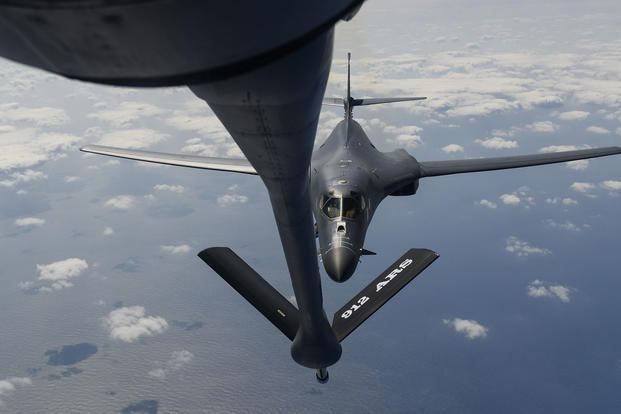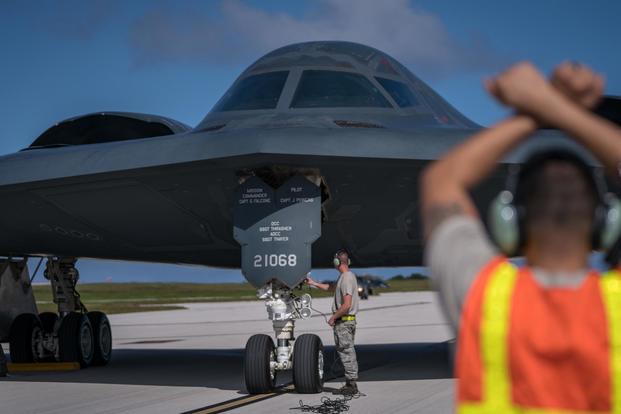The Air Force will begin retiring its B-2 Spirit and B-1B Lancer bombers in the 2030s as it builds up its new B-21 Long Range Strike Bomber fleet.
The service will also pump more money into the B-52 Stratofortress platform, according to a service announcement Monday.
The new "Bomber Vector" strategy comes with the service's fiscal 2019 budget rollout to allocate more resources for the nuclear-capable B-52.
The Air Force is pushing for a major engine overhaul for the BUFF, or "Big Ugly Fat Fellow," as it intends to keep the long-range B-52 flying into the 2050s.
Related content:
- Arms Control Experts: US Not Planning Nuke Strike Against North Korea
- With Nuclear Mission in Rear-View, Options Abound for B-1B
- Air Force: We Want 165 Bombers, Not Just B-21s
"As part of our decisions presented in the FY19 President's Budget, the Air Force will update the B-52 bomber fleet and fund development of replacement engines," said Secretary of the Air Force Heather Wilson. "We will also continue necessary B-1 and B-2 modifications to keep them relevant until the B-21s come on line."
Once sufficient B-21 aircraft are operational, the B-1s and B-2s will be incrementally retired, the service said in the release.
"Delivery and retirement timelines are dependent on the B-21 production and delivery schedules," the statement said.
"If the force structure we have proposed is supported by the Congress, bases that have bombers now will have bombers in the future," Wilson added. "They will be B-52s and B-21s."
The nonnuclear B-1s will stick around until 2036 and the B-2 until at least 2032, according to a draft report of the Vector roadmap, first obtained by Air Force Magazine.
That's enough time to bring in new pilots, train them and have them fly each bomber for at least 15 years.
The B-1 retirement has been expected for some time. B-1 operators recently told Military.com they are keeping in mind how their mission may shift in preparation for the B-21 Raider -- the Pentagon's latest classified, multi-billion-dollar program in development by Northrop Grumman Corp.
"We try to posture ourselves as best we can so that if the [B-21 Raider] does come here -- leaders, our senior leaders make that decision to bring it here -- that we're ready," said Col. Brandon Parker, 7th Bomb Wing commander, during a roundtable discussion Dec. 18 at Dyess Air Force Base, Texas.
"But until it comes, we're going to fly these B-1s ... full speed ahead. We're an afterburner, and we're going to go as full speed ahead as best we can," he said.
The B-2, the Pentagon's most advanced stealth bomber, will continue to degrade in technology compared to the B-21, which will have both nuclear and non-nuclear roles.
Conventionally, the B-21 can go after multiple targets, but can carry out only one nuke drop at a time. The first B-21s are expected to reach initial operating capability in the mid-2020s.
What's most telling about the latest plan is how much the Air Force is willing to invest in the Cold War-era Stratofortress.
According to fiscal 2019 budget documents, the service is requesting $280 million for B-52H upgrades, a $168 million increase from the previous year. That includes money to "modernize our bomber fleet to include development of the B-52H replacement engines," according to the documents.
Compared to its bomber cousins, the B-52's longevity, endurance and payload will continue to expand, argued Joe Biles, a B-52 weapons officer and instructor weapons system officer in the Air Force Reserve.
"The B-1 community (I don't blame them) frequently cites the statistic that they can carry (75K vs 70K [pounds] of weapons) a larger payload than the B-52," Biles Tweeted on Sunday. "In reality, those are theoretical payloads. The actual loadout that gets closest to using that capacity on either jet is a full load of AGM-86B ALCM on the B-52, weighing in at 62,660 lbs."
The B-52 is losing the Air Launched Cruise Missile, or ALCM. The Long Range Standoff Weapon program, known as LRSO, will replace the AGM-86B ALCM, developed in the early 1980s.
The Pentagon awarded Lockheed Martin Corp. and Raytheon Co. contracts to begin preliminary work on LRSO in August.
Biles went on to say that while the B-1 can carry more GBU-31 Joint Direct Attack Munitions and Joint Air-to-Surface Standoff Missiles, or JASSMs, it lacks in JDAM variants because of spacing issues in its weapons bay.
By comparison, with its new conventional rotary launcher, the B-52 has the ability to launch 24 precision-guided bombs -- a new record the aircraft recently set in Afghanistan.
The service wants to procure 100 of the Raiders, named after the Doolittle Raiders.
The Air Force currently has 62 B-1B Lancers, 20 B-2 Spirits, and 76 B-52 Stratofortresses, totaling 158 bombers, according its inventory.
It intends to have 61 B-1s by fiscal 2019, the documents show.
-- Oriana Pawlyk can be reached at oriana.pawlyk@military.com. Follow her on Twitter at @Oriana0214.













